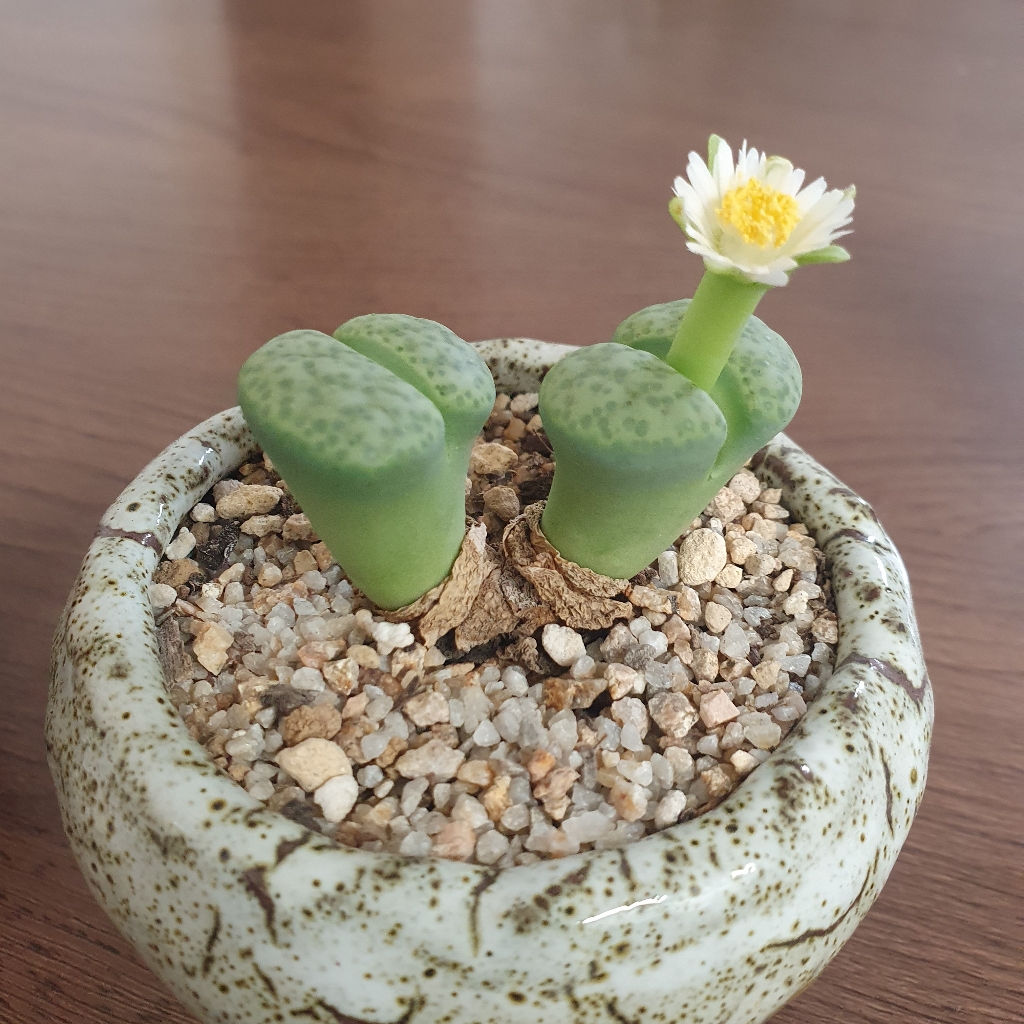How to grow and care for Lithops localis
plant care guide about watering, fertilizing, trimming, repotting, cutting, propagating Lithops localis
Lithops localis 101 - Plant Care Instructions
Bright indirect light
16C° ~24C°
Every 14 days
Botany Encyclopedia
Genus : Lithops
🔖 Care Tips
Plants grow through a process called molting, typically occurring in summer, though some plants molt in spring or fall. Molting usually begins between January and March, and before it starts, leaves may wrinkle and change color. Avoid manually removing leaves during this time to prevent plant damage. Molting generally takes about a month, but can extend 2-4 weeks longer depending on the plant. Plants typically grow from fall to spring (September to May) and enter dormancy in summer (June to August). For seed germination, it's best to plant in fall to avoid the hot and humid summer. Maintain temperatures of 15-20°C during the day and 5-10°C at night to increase germination rates. Use bottom watering until moisture appears on the surface, and cover with plastic wrap or a lid to maintain humidity during germination. Ventilate periodically to prevent overwatering and ensure the surface doesn't dry out. Germination takes about 1-3 weeks, and once over 50% of seeds have germinated, gradually increase light exposure in a cool place. The first molting begins approximately 2-3 months later.
🏝️ Habitat Conditions
This plant grows in the deserts of South Africa. It prefers hot and dry conditions in summer, and cold and humid environments in winter.
🪨 Soil Mix
Plants that prefer dry environments should be planted in well-draining soil. Typically, succulents use a soil mix of potting soil and pumice in a 3:7 ratio. However, this ratio can vary depending on the situation and environment.
🌡️ Environment
The ideal temperature range is 5-25°C. If it drops below 5°C, the plant may enter dormancy. It can briefly withstand temperatures as low as -4°C, but prolonged exposure is dangerous. If humidity is too high, the plant may become soft. During humid summer periods, place the plant in a well-ventilated area or use a fan or air circulator.
☀️ Light
Direct sunlight can change the leaf color. Avoid direct sunlight and provide bright light. Be cautious, as insufficient light can cause the plant to grow long. In summer, using a 50% shade cloth is beneficial.
💧 Water
After shedding, the plant starts to grow, so gradually increase watering. From fall to spring, water thoroughly when the soil is completely dry. In summer, the plant enters dormancy. Water lightly to keep the soil surface moist when it dries out. Avoid watering plants during shedding as much as possible. Wrinkled leaves indicate a lack of water; water the plant in this case. As a CAM plant, it's best to water in the evening for more effective absorption than during the day.
🌱 Propagate
It primarily reproduces through seeds. The germination rate is higher than other succulents, and seeds can germinate even after 10 years. However, the survival rate is low, so careful management is necessary. Seeds can form without pollination, but for stable self-pollination, it's recommended to use a cotton swab or brush for pollination.
🪴 Repot
Due to its slow growth rate, it is best to repot the plant between September and November, after it has shed its old leaves every 2-3 years. Delaying this may result in slower root development due to the cold. Since the plant tends to develop deep roots, it is advisable to plant it in a deep pot.
💊 Fertilize
During the growing seasons of fall and spring, using fertilizer once each while adhering to the recommended amount can promote more vigorous growth.
🌺 Flower
Flowers bloom from September to November, and it's best not to water them during the blooming period.
😵 Toxicity
Non-toxic and safe for pets and children.
water
How to water Lithops localis
How often should I water?
check Lithops localis Every 14 days if it needs water when it’s very cold (below 5℃), water less frequently
When do I need to water?
The soil should be at least 90% dry before watering again. this means about every 2 weeks in the warm season and about every 4 weeks in the cold season
Signs that it really needs water
leaves look a little wrinkled
Light & Location
How much light does a Lithops localis need?

Bright indirect light
Grow light
Light preference
Lithops localis likes Bright indirect light, Grow light day. The brighter the space, the better this plant grows.
Check if there’s an optimal place in your house!
This plant prefers
2K ~ 10K lux to thrive!
0
20K~
2K
10K
Temperature
Houseplants
-15
16~24℃
45
Plants that grow in the wild and those that grow indoors prefer different temperatures. If you grow Lithops localis at home, make sure the temperature is 16~24℃.
Humidity
Ideal humidity
0
40~70%
100
Lithops localis prefers humidity about 40~70%. If necessary, increase humidity by misting, humidifier.
Fertilize
Collective Knowhow
When should I fertilize?
Only when your plant is healthy
How frequently should I fertilize?
1-2 times in growing season. A pinch for a small pot.
Characteristic
The taxonomic classification of Lithops localis is as follows. - Kingdom: Plantae, Phylum: Tracheophyta, Class: Magnoliopsida, Order: Caryophyllales, Family: Aizoaceae, Genus: Lithops, Species: Lithops localis
| Taxonomy Name | Taxonomy Value |
|---|---|
| Phylum | Tracheophyta |
| Class | Magnoliopsida |
| Order | Caryophyllales |
| Family | Aizoaceae |
| Genus | Lithops |
| Species | Lithops localis |
Is your plant sick?
Track what happened. We’ll let you know the cause and treatment shortly!





1:1 Expert Help
You’ll get professional feedback within 24 hours from an expert on our team.
feedback will include




